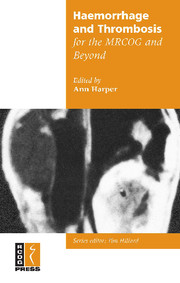Book contents
- Frontmatter
- Contents
- About the authors
- Abbreviations
- Preface
- 1 The coagulation system in pregnancy
- 2 Pregnancy in women with inherited bleeding disorders
- 3 Maternal and fetal thrombocytopenia
- 4 Massive obstetric haemorrhage
- 5 Disseminated intravascular coagulation
- 6 Gynaecological problems in women with bleeding disorders
- 7 Venous thromboembolism in obstetrics and gynaecology
- 8 Genetic thrombophilias and antiphospholipid antibodies
- Index
6 - Gynaecological problems in women with bleeding disorders
Published online by Cambridge University Press: 05 October 2014
- Frontmatter
- Contents
- About the authors
- Abbreviations
- Preface
- 1 The coagulation system in pregnancy
- 2 Pregnancy in women with inherited bleeding disorders
- 3 Maternal and fetal thrombocytopenia
- 4 Massive obstetric haemorrhage
- 5 Disseminated intravascular coagulation
- 6 Gynaecological problems in women with bleeding disorders
- 7 Venous thromboembolism in obstetrics and gynaecology
- 8 Genetic thrombophilias and antiphospholipid antibodies
- Index
Summary
Excessive or abnormal vaginal bleeding are the most common symptoms when women present to a gynaecologist. The cause is usually gynaecological pathology but occasionally gynaecologists may encounter women with such symptoms secondary to inherited or acquired bleeding disorders. This chapter aims to increase awareness and provide basic information about these relatively uncommon disorders. Gynaecological complications associated with these disorders and their management will also be discussed.
Inherited bleeding disorders
VON WILLEBRAND'S DISORDER
Inherited bleeding disorders in women are far more common than previously suspected. Von Willebrand's disorder seems to be the most common inherited haemorrhagic disorder in women, with an estimated prevalence of 1–3%. Von Willebrand's disorder is a consequence of quantitative and/or qualitative defects of von Willebrand factor (VWF), a protein that is necessary for platelet adhesion and thrombus formation and which also serves as a carrier for factor FVIII.
Von Willebrand's disorder demonstrates extreme clinical and genetic heterogeneity depending on the subtype considered. There are three main types: types 1 and 3 caused by quantitative and type 2 caused by qualitative defects in VWF protein.
• Type 1 (70% of all cases) is the most common form of the disease. It is characterised by low plasma levels, usually between 5 iu/dl and 40 iu/dl, of FVIII (normal range 50–150 iu/dl) and VWF (normal range 50–175 iu/dl). This is caused by reduced production of normally functioning VWF, resulting in a secondary defect of FVIII.
Keywords
- Type
- Chapter
- Information
- Haemorrhage and Thrombosis for the MRCOG and Beyond , pp. 72 - 89Publisher: Cambridge University PressPrint publication year: 2005



